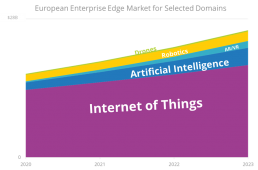In the new connected world, where intelligence has become more imperative than ever for every enterprise that wants to improve performance, lower the costs, and better manage its valuable data edge computing is needed to dramatically reduce time to value and to immediately enable business processes, and decisions.
With this rapidly evolving connected device ecosystem, the demand for short and long-term storage, real-time data analysis and increased security, without overburdening the centralized data center, having the data closer to the source will become the norm for optimizing networks and data management.
This is exactly how Edge comes into play: compute and storage are performed outside of the centralized datacenter, being the intermediary (and vast) space between the connected endpoints and the core IT Environment, a datacenter, or a central cloud location.
Edge Computing in Europe
Our research shows that European enterprise edge spending is expected to double from 2020 to 2024, driven by the role of edge in enabling low latency use cases, deployments in locations that are either remote or without IT support staff, and support from many new vendor propositions and a supply chain that is currently being built up.
Edge computing’s rapid enhancement across Europe is driven by edge-cloud combined architectures/deployments, enabling a continuum of data processing and storage capabilities from the cloud to the most remote parts of networks where endpoints are located. And within this continuum a vast spectrum of players is becoming key leveraging their own proposition and portfolios, or alliances and partnerships, from infrastructure vendors to cloud players, from connectivity and service providers to ISVs.
According to the latest IDC Worldwide Edge Spending Guide, spending by European enterprises on public cloud services at the edge will outpace average public cloud growth rates, with revenues tripling from 2020 to 2024.Edge colocation will grow extensively as well, highlighting how the build out of the Edge value chain will reshape the IT environment for end-user companies.
The foundation for leveraging the opportunities around edge and cloud deployments stays in the ecosystems of partners. According to IDC FutureScape: Worldwide Cloud 2021 Predictions, 25% of organizations will improve business agility by integrating edge data with applications built on cloud platforms, enabled by partnerships across cloud and communications service providers.
Starting from the role of communications services providers capabilities on edge market, another driver for edge computing is going to be 5G who can support edge deployments to increase speed and to eliminate latency issues and enable huge amounts of data to be processed in real-time, amplifying edge’s capabilities and unlock new solutions and large-scale deployments. This suggest how Edge could be important especially in relation to, or enabling, other technologies.
Edge Computing Drivers and Case Studies
We see different domains driving the overall edge market. A large part of Edge still resides in supporting and automating traditional IT workloads. Nevertheless, there are 5 innovative areas that will be increasingly interesting for Edge: Internet of Things, Artificial Intelligence, AR/VR, Robotics and Drones.
- Internet of Things
We estimate that the overall number of “connected” IoT devices worldwide will increase to over 39 billion by 2024. All these endpoints, sensors and devices, will reside at the edge, generating an enormous and skyrocketing amount of data.
This data needs to be used to create value, but this monetization process cannot reside only in the core or in the cloud. It is just unacceptable for low latency use cases, or not sustainable due to the cost of transferring massive amount of data, like in security and video surveillance cases.
Edge helps in performing computing where most appropriate for the use case, closer to the point of where data is generated and acted upon, helping to manage large amount of data, reducing time-to-action and at the same time, allowing IoT processes active even when disconnected. Over the forecast period, the IoT component will represent more than half of the total Enterprise Edge market.
Real case study: Alstom has recently announced a partnership with Red Hat to leverage IoT and Edge solutions in their railway business, to improve signaling reliability and railway network velocity by upgrading the way railway devices communicated with trains and back-office systems to help better predict and track issues that may occur, while also working to fix equipment and reroute vehicles in real time.
- Artificial Intelligence
Nowadays, being able to process the data in real time, extract critical pieces of information, structure the information and finally connecting the dots between different pieces of information is critical for every company who wants to transform their most valuable data into actionable insights.
Machine learning and Artificial Intelligence requires an extensive base of data, with higher computational and storage capabilities found not only in the core datacenter of a company or in the cloud but also at the edge.
While AI model training is mainly performed in core locations, the case for edge AI inferencing is becoming more prominent. Back in 2018 already 40% of European companies were looking at edge locations to deploy AI inferencing.
With the advancements in the silicon industry and the ability to run increasingly efficiently AI models on small footprint devices, Edge is becoming the preferred environment where AI models will be applied, with benefits in terms of time-to-value, continuity and cost effectiveness of the use cases.
According to our research, the AI component of the Edge will become increasingly important, driving 10% of the market and doubling is market share by 2024.
Real case study: In order to improve inspection performance for its customer, a well-known fruit and vegetables’ sorting, grading and packaging machine manufacturer, Advantech provided an integrated Edge AI software and hardware solution consisting of an inference system and a vision processing unit, transforming the very time-consuming, labor-intensive and expensive process of grading and inspection into a more accurate and efficient one, using AI technologies.
- Augmented and Virtual reality
Augmented reality (AR) and virtual reality (VR) are two different but related technologies that represent a profound change in the way humans interact with computers, either to overlay digital information or objects with a person’s real-world view of reality or to be fully immersive, placing users into a completely new reality, obscuring the view of their surrounding real-world environment.
The critical role of technicalities as low latency, high bandwidth, storage and security capabilities to retrieve real-time data can make the AR/VR the perfect candidate for Edge deployments, combining the disruptive effect of both technologies. Despite its light weight in the European edge computing landscape in 2020, augmented reality/virtual reality (AR/VR) will be the fastest-growing domain, with a 3-year CAGR of over 70%.
Real case study: Fiat Chrysler Automobiles and Google cloud are working together to provide virtual experiences for potential customers when making purchasing decisions even though they cannot see the actual product by streaming it directly to devices. A combination of AR technology and edge computing can display the prototype of the actual product in 3D view. The solution has been part of the FCA’s Virtual Showroom CES event in January 2021.
- Drones
Drones are inherently edge devices. They can be used to collect real-time environmental data, 3D mapping, compliance, aerial photographs and so forth, especially in the transportation industry. Also, drones can provide information for tracking the progress of a large project, identifying potential safety hazards, or inspecting hard-to-reach places.
In this scenario, the role of Edge in the process of taking real-time decisions based on aggregated and localized information from multiple sources, in a secure and very fast way, is crucial for the safe use of drones.
According to our research, drones’ market is experiencing steady growth, with European spending on drones expected to reach a 9% CAGR by 2025, while the drones component of edge market will grow at an even higher rate
Real case study: E-FLY is an Innovation Activity funded by EIT Digital. It is a drone solution integrating edge computing and AI video processing capabilities to perform critical infrastructure inspection and allow fast responses without delays in a cost-efficient way that optimized data management and analysis. The solution has been validated on real inspection pilots on Enagas gas pipeline infrastructure in Spain, which was managed by Ferrovial.
- Robotics
We define robotics as technology that encompasses the design, building, implementation, and operation of robots. Robots are machines and systems that can operate autonomously (or semi-autonomously) to complete a particular task or process.
Depending on their variety of functions, some robots are capable of instant decision making and reasoning in complex environments, collaborating and interacting with customers. Therefore, edge computing can support these functions enabling real-time data processing, without connectivity interruptions. This kind of robots can learn and make decisions to support optimal function and performance and can be designed to support commercial operations.
The current pandemic situation has forced many companies to readjust their operations in order to prevent possible disruptions. Industries such as healthcare, retail or manufacturing have started using robots and drones to support health and safety measures (such as cleaning, disinfecting, or delivering medicines/medical equipment) or to fill the workforce gaps due to social distancing measures. Additional to robots and drones, companies can leverage the use of edge computing and 5G to build fully autonomous, zero-touch production facilities. As for drones, the expectation of Edge Robotics market in Europe will outpace the average robotics one, with a 3-year CAGR of 14%.
Real case study: German microcar manufacturer e.GO partnered with Ericsson and Vodafone to build such a production facility, using 5G and edge computing with pervasive secure and “almost real-time” data networking across the production chain. The secure automatic identification and delivery of production materials to each specific vehicle as it goes through the assembly process — alongside fully autonomous vehicles replacing the traditional production line to move vehicles from station to station — increases operational speed and efficiency across the chain.
For more information about the European Enterprise Edge market sizing and forecast, domains, technology, and industry trends, please contact Gabriele Roberti or Alexandra Rotaru, or head over to https://www.idc.com/eu and drop your details in the form on the top right.



